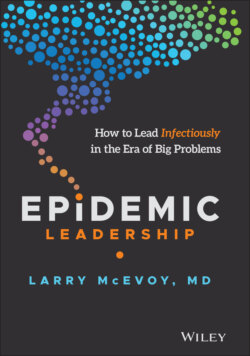Читать книгу Epidemic Leadership - Larry McEvoy - Страница 14
Good People, Bad Disease
ОглавлениеIn 2008, several years removed from my discouraging night in the ER, I took a role as the CEO of what was then Colorado's largest trauma center. I entered an organization rife with internal strife and external pressures. I had to familiarize myself quickly with a new organization, five thousand new colleagues, teammates, and opinions, and a city-owned health system in a national financial meltdown. Three days' worth of cash on hand stood between us and our debt holders' right to come in and run the place, and we had $320 million of bond debt tied up in the auction-rate bond market, which collapsed midyear, leaving us with worthless and burdensome debt and no bank willing to help us restructure it. Our compliance with federal guidelines was suspect at best, and the penalties for compliance violations were high and included incarceration of the “designated jailable officer”—me. Our finances were sagging after five years of investing in a new hospital with gorgeous brick and glass without replacing the numerous pieces of expensive technology that were reaching the end of their life cycles.
Nationally, we were entering a recession, which always decreases traffic to hospitals and clinics, and our city, strapped for cash as a sales-tax municipality, was hoping we would fund the city's budget, either by funneling cash flow or by selling the organization. All over the country, cities, states, and the nation itself puzzled constantly over how to fund health care, and I had landed in a town that wanted health care to fund the city.
We had no firm plan for working with physicians to improve and innovate the clinical care. Relationships with and between physicians themselves were poor, rife with manipulative competition, collegial distrust, and a long history of triangulation with the hospital's need to keep beds full. Within a month of my arrival, a patient told a nurse he was having a heart attack, and, despite repeated attempts by him and his family to tell us how ill he was, we only figured it out a few hours later when he died. The physicians blamed the nurses, the nurses blamed each other, and everyone blamed administration.
We had too much to fix and not enough time to do it. We had lots of policies and no consistent practices. We had lots of opinions and very little shared insight. People were hoarding clinical supplies in closets and above the ceiling tiles. We lacked operating processes, procedural rigor, and cultural alignment. We had chaos.
On top of safety risks, lagging results, and broken processes in the setting of a crashing economy, we had a more ominous problem. As I walked the halls and spoke with doctors, nurses, clerks, and pharmacists, I kept hearing we had a leadership problem. From leaders, I kept hearing we had “the wrong people.” I also kept hearing from people who had worked there a long time, who loved the place, and who wanted to be very good at their jobs. They took great pride in their professions and truly wanted to help people. When I asked them what they thought we needed to do to address the woes we were experiencing, I received a lot of head shakes, eye rolls, and muttering, but they all sent the same message: “This place can't change. Don't even try. It's been this way for years. You'll see.”
We had an internal lean coach named Jauna Werner who had arrived a bit before I did. She was skilled in facilitating shifts to lean thinking, but she was even more astute as an observer of all the little things that underpinned how a system was functioning. As she rounded through the organization, looking at operational processes and listening to people, she had come to an interesting conclusion.
“This place could benefit a lot from lean, but not yet. It needs therapy first. Maybe gene therapy.” We had all the hallmarks of a degraded ecosystem. Performance was sagging and widespread. Our ability to adapt was mired in entrenched frustration and apathy. Our biodiversity of thought and perspective had been winnowed to a few surviving patterns, and energy was low.
I spoke to and listened to hundreds of people. From a clinical perspective, I was fascinated with the ubiquitous combination of personal commitment and collective malaise. From an executive perspective, I sensed that we could fix all the policies, processes, and protocols we wanted, but until we got at the more foundational, lurking source of will in the organization, we would be wishing for results rather than creating them. I had a big whiteboard in my office, and after a month or so of scrawling on it with notes, pictures, and network diagrams in different colored markers, I wrote in big red letters with a circle around them, “CPD.”
